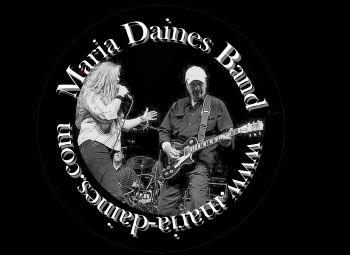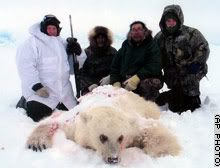
Maria Daines
|
5/13/2006 11:22:22 PM
It was beautiful, it was unique....So they SHOT IT !!!

Grizzly-polar bear hybrid found
Thursday, May 11, 2006; Posted: 7:37 p.m. EDT (23:37 GMT)
Hunter Jim Martell, left, with a hybrid bear he shot
on Banks Island, Northwest Territory, Canada.
TORONTO, Ontario (AP) -- A DNA test has confirmed what zoologists, big-game hunters and aboriginal trackers in the far northern reaches of Canada have imagined for years: the first documented case of a hybrid grizzly-polar bear in the wild.
Roger Kuptana, an Inuit tracker from the Northwest Territories, suspected the American hunter he was guiding had shot a hybrid bear last month after noticing its white fur had brown patches and it had the long claws and slightly humped back of a grizzly.
Territorial officials seized the creature's body and a DNA test from Wildlife Genetics International, a lab in British Columbia, has confirmed that the hybrid was born of a polar mother and grizzly father.
"It's something we've all known was theoretically possible because their habitats overlap a little bit and their breeding seasons overlap a little bit," said Ian Stirling, a polar bear biologist with the Canadian Wildlife Service in Edmonton. "It's the first time it's known to have happened in the wild."
He said the first person to realize something was different about the bear -- shot and killed on the southern end of Banks Island in the Beaufort Sea -- was Kuptana, the guide.
"These guides know their animals and they recognized that there were a number of things that didn't look quite right for a polar bear," Stirling said. The bear's eyes were ringed with black, its face was slightly indented, it had a mild hump to its back and long claws.
Stirling said polar bears and grizzlies have been successfully paired in zoos and that their offspring are fertile, but there has been no documented case in the wild.
Kuptana, a guide from Sachs Harbour in the Northwest Territories, was tracking with Idaho big-game hunter Jim Martell, who had paid C$50,000 (US$45,500, or euro35,800), for a license to hunt polar bears.
The DNA results were good news for the 65-year-old hunter, who could have been fined or jailed for up to a year for shooting a grizzly. The Northwest Territories Environment and Natural Resources Department now intends to return the bear to Martell.
"It will be quite a trophy," Martell told the National Post newspaper last week, before the DNA results were in. He is now in Yellowknife for another hunt, this time with a permit to shoot a grizzly bear. Martell told the newspaper he has dubbed the hybrid creature a "polargrizz."
Stirling said others in his office have been tossing around in jest possible names for the hybrid: a "pizzly" or a "grolar bear." One colleague said they ought to call it "nanulak," combining the Inuit names for polar bear -- "nanuk" -- and grizzly bear, which is "aklak."
"He has a remarkable trophy from his perspective and from the perspective of this whole fraternity of people who like to go big-game hunting for trophies," said Stirling. When asked how he felt about the rare beast being killed, he said that Canada's polar bear hunt -- which runs from December through the end of May -- is done on a sustainable basis.
Colin Adjun, a wildlife officer in Kugluktuk on the northern mainland in western Nunavut, said he has heard stories before about an oddly colored bear cavorting with polars.
"It was a light chocolate color along with a couple of polar bears," Adjun said. Though people have talked about the possibility of a mix, "it hasn't happened in our area," he said.
Three years ago, a research team spotted a grizzly on uninhabited Melville Island, about 350 kilometers (220 miles) north of where Martell bagged his crossbreed.
Polar bear and grizzly territory also overlap i
|

|